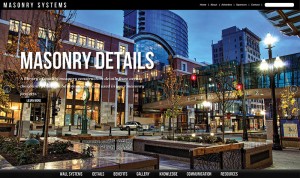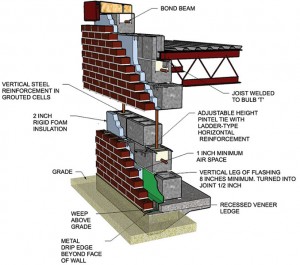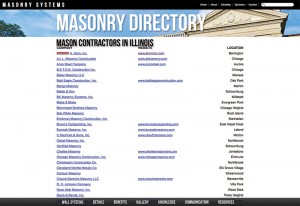A Resource for Structural Engineers
MasonrySystems.org is the brainchild of the Masonry Executives Council (MEC), a coalition of professionals from more than two dozen masonry associations. The goal of the website is to provide a unified source of inspiration and information about masonry design and construction. By working together, these associations are striving to make it easier for architects, engineers, developers, school boards, and city officials to choose to use masonry for their buildings.
The site is broken down into seven sections:
- Wall Systems
- Details
- Benefits
- Gallery
- Knowledge
- Communication
- Resources
Designed to provide a user-friendly experience to visitors, all content can easily be accessed from the site’s unique navigation menu (Figure 1).
“Our overall goal for the MSO website was to create a user-friendly, aesthetically pleasant, and informational website that is used as an industry standard not only for masonry contractors, but also for architects, owners, masonry suppliers, and other interested parties,” said Imani Brodie, Geotechnical & Environmental Products Engineer at Carolina Stalite Company. “With this new design, I do believe we have achieved all of these goals.”
Masonry Wall Systems
MasonrySystems.org allows visitors to determine which masonry wall system is right for their next building, and learn why masonry structures outlast and outperform every other building system. The site features an extensive selection of various masonry wall systems that comply with current codes.
Each wall system page provides detailed diagrams of the system, along with a 3D model that can be downloaded into Trimble’s SketchUp (see Figure 2, for an example of brick veneer and reinforced CMU). Extensive design tips and considerations have been provided that reference specific codes and standards that apply to the wall system, as well as free downloadable resources.
The site makes it easy for you to determine what building type each wall system is best suited for, along with the benefits of using that specific wall system. But that’s not all; you can find the fire rating, sound transmission class, energy rating, and LEED rating for each system.
What if you don’t know what type of wall system is best for your project? Not to worry! MasonrySystems.org has you covered there too. Simply go to the “Help Me Choose” feature, answer a handful of short questions, and the site will provide you with a recommended wall system and alternative wall systems that work for your project.
For example, let’s say you’re the structural engineer working on a museum with a stone exterior. Simply select your building type, life expectancy, and exterior, and you’ll be taken to a page that recommends using a cavity wall with a stone slab veneer and reinforced concrete masonry.
Masonry Construction Details
The latest and greatest addition to MasonrySystems.org is the Masonry Construction Details section.
Select your state and you’ll be able to view a library of quality masonry construction details. It’s a quick and simple way to access hundreds of free masonry details that can be download into your CAD program. From wall sections and control joints to window jambs and flashing, the site has everything and anything you’re looking for.
Benefits of Masonry
Using a masonry system for your next project will help you deliver a completed, structurally sound building in the shortest period of time. Masonry buildings go up fast and last.
There are a number of significant benefits of masonry, including its performance under fire conditions as well as life safety, cost-benefits analysis, and mold. And, the energy saving characteristic of a masonry system wall is second to none.
MasonrySystems.org highlights all of these benefits, and provides dozens of resources including videos, articles and publications that can be downloaded or purchased and used to help get the most out of your next project.
And you won’t want to miss out on the masonry facts. Each time you visit the site, a new fact about masonry will appear to educate visitors on the many benefits and aspects of masonry. For example, did you know one 8-inch CMU can support 205 sumo wrestlers weighing 500 pounds each? You never know what you might learn when you visit MasonrySystems.org!
Get Inspired
Discover the beauty and versatility of brick, block and stone by browsing hundreds of masonry buildings across the country in the Project Gallery (Figure 3).
Projects can be viewed by category: College and University, Commercial Education: 9-12, Education: K-8, Government, Industrial, Institutional, Landscape/Hardscape, Rehabilitation/Restoration, Residential: Multi-Family and Single Family.
Along with photos showcasing the masonry aspects of the structure, each project features a vast amount of information, including details about the architect, structural engineer, mason contractor and suppliers who worked on the project; an in-depth description of the project highlighting why masonry was selected and the benefits gained from using masonry; and, a direct link to information and details about the wall system used on the project.
There is even a section that allows visitors to submit their own masonry project to be added to the gallery and featured on the site.
Nearly three hundred projects can be viewed in the constantly expanding gallery.
Knowledge Base
Do you need engineering information about masonry and need it fast? The Knowledge Base is where you’ll want to navigate.
The knowledge base is the heart and soul of MasonrySystems.org, acting as a clearinghouse of everything masonry. There are apps to use in your browser, free presentations to download, and videos to watch. You’ll be able to view hundreds of resources and barely scratch the surface of all the content that is available.
If you’re unfamiliar with masonry, there’s even a glossary featuring common masonry terms with definitions, photos, and detailed information to help get you up to speed.
Communication Center
Have a question about masonry? Post it in the Communication Center. These interactive, online forums allow visitors to share problems and solutions, and bounce ideas off one another.
Visitors can discuss structural design and performance of masonry wall systems, masonry construction issues, tools and equipment, and logistics. There is a forum for everyone, and a great community of masonry experts ready and willing to share their knowledge.
Masonry Resource Directory
The robust Masonry Directory (Figure 4) allows visitors to search nearly five thousand profiles of mason contractors, general contractors, architects, structural engineers, masonry suppliers, masonry associations and masonry instructors.
Each project includes company contact information, areas of work each company specializes in, and photos of projects the company has worked on.
The Only Masonry Resource You Need
Whether you have just a few minutes to find specific information or several hours to browse the hundreds of projects and details housed on the site, MasonrySystems.org will be an excellent resource for every practicing structural engineer.
“I encourage and all but demand that you go check out the site for yourself,” said Brodie. “My hope is that you are both pleasantly surprised and inspired to return to the site in the future.”
We hope that you will visit and read the entire MasonrySystems.org website and hopefully make the decision to “go masonry” on your next project.▪




